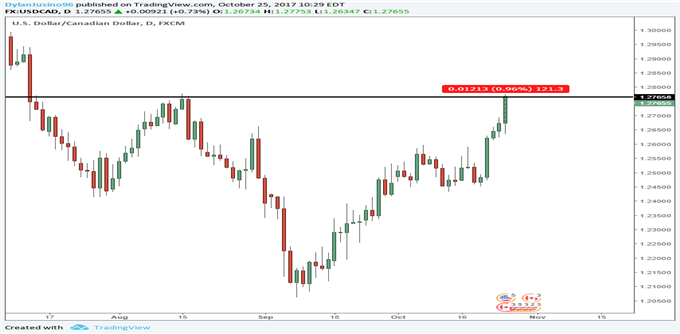Talking Points:
- The Bank of Canada (BOC) left the overnight lending rate unchanged at 1.00% as was widely anticipated.
- Today's MPR provides insight to a less optimistic inflation expectations and economic outlook.
- Canadian Dollar generally falls as BoC sees economy cooling
- See the DailyFX Economic Calendar for upcoming economic data and for a schedule of live coverage see the DailyFX Webinar Calendar.
As markets were expecting, the Bank of Canada held their overnight interest rate at 1.00% at this October monetary policy meeting. In the Monetary Policy Report, the BOC discussed inflation around +2%, moderate GDP growth in 2017, and a neutral a rate between 2.5% to 3.5%. See the full Monetary Policy Report here.
Inflation
The BOC stated that “globalization is not a significant contributor to recent inflation softness.” In regards to the consumer price index (CPI), the central bank noted that “inflation has recently picked up from low levels, reflecting higher gasoline prices, dissipating drag from food inflation, and improving economic conditions.” Inflation is expected to to rise toward 2% as the “temporary effects of past fluctuations in food and electricity prices fade.”
Notably, the BOC expects the Canadian Dollar to have a “dampening impact” in 2018,while the absorption of economic slack is will have a smaller, opposite effect. In 2018, the central bank expected inflation to increase close to +2% and to remain around +2% until the end of 2019.
Wages
In regards to wages, the BOC mentioned that “there is evidence of slack remaining in the labour market.” This includes average hours worked which is still below trend.The central bank further stated that “other evidence of labour market slackcomes from the BOC labour market indicator,which remains high relative to its level before the Great Recession, and from the labour force participation rate ofyouth, which remains low.”
Economic Outlook
In regards to the BOC’s projection of the Canadian economy, Officials stated that, “the level of economic activity will be supported by rising foreign demand and the recent firming of commodity prices, still-accommodative monetary and financial conditions, and public infrastructure spending. The economy is expected to progress on a more sustainable path: the total contribution to growth from consumption and residential investment is projected to decline, in part because of recent interest rate increases, while the contribution from exports is expected to improve and that from business investment to remain steady.”
The central bank further explains that gross domestic product growth is revised up for the year. This is mainly attributed to “unexpected strength in household consumption and business investment in the second quarter.” The BOC expects GDP to grow by +2.1% in 2018 and +1.5% in 2019. Overall, the central bank expects economic activity to remain close to full capacity or modestly above depending on supply and economic developments; moderate growth is expected in the second half of 2017 according to the BOC.
The BOC expects that the Canadian Dollar is assumed to remain close the its recent average of 0.81 per USD over the central bank’s “projection horizon.” The central bank’s neutral rate is estimated to be between 2.5% to 3.5%. The midpoint range remained unchanged for this period.
Chart 1: USD/CAD Daily Timeframe (July to October 2017)

Following the release of the Monetary Policy Report, the Canadian Dollar fell sharply against the US Dollar, with USD/CAD hitting its highest level since mid-August. At the time this report was written, the pair was up around +1% on the day.
See our longer-term forecasts for the US Dollar, Euro, British Pound and more with the DailyFX Trading Guides
--- Written by Dylan Jusino, DailyFX Research






